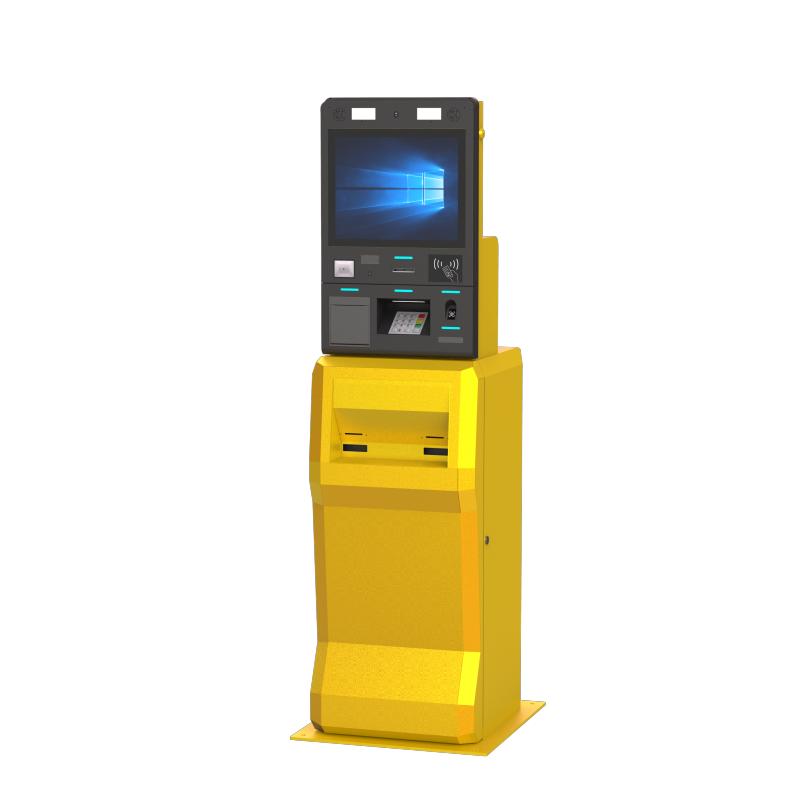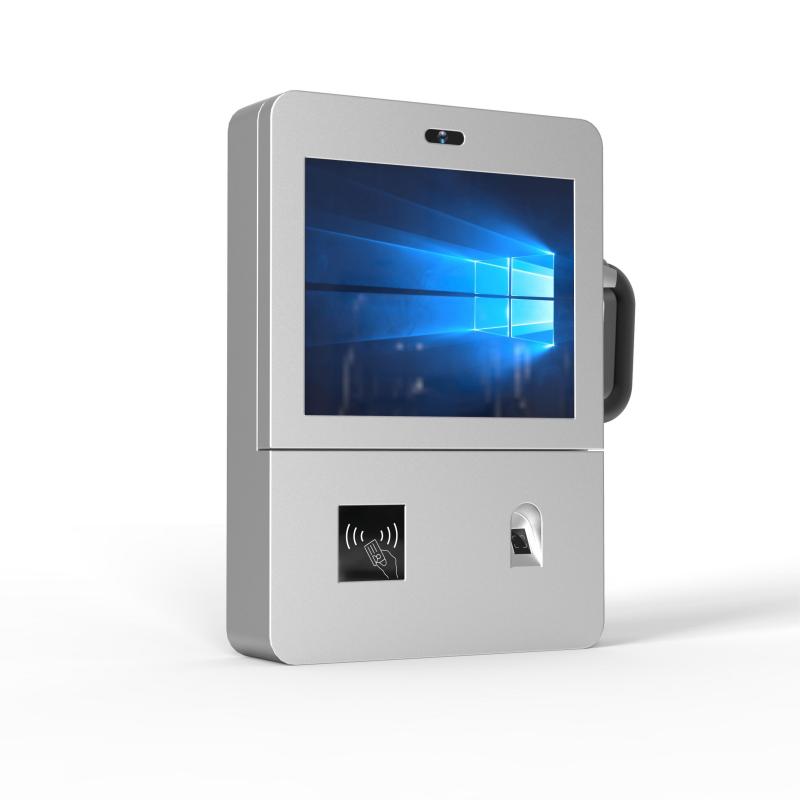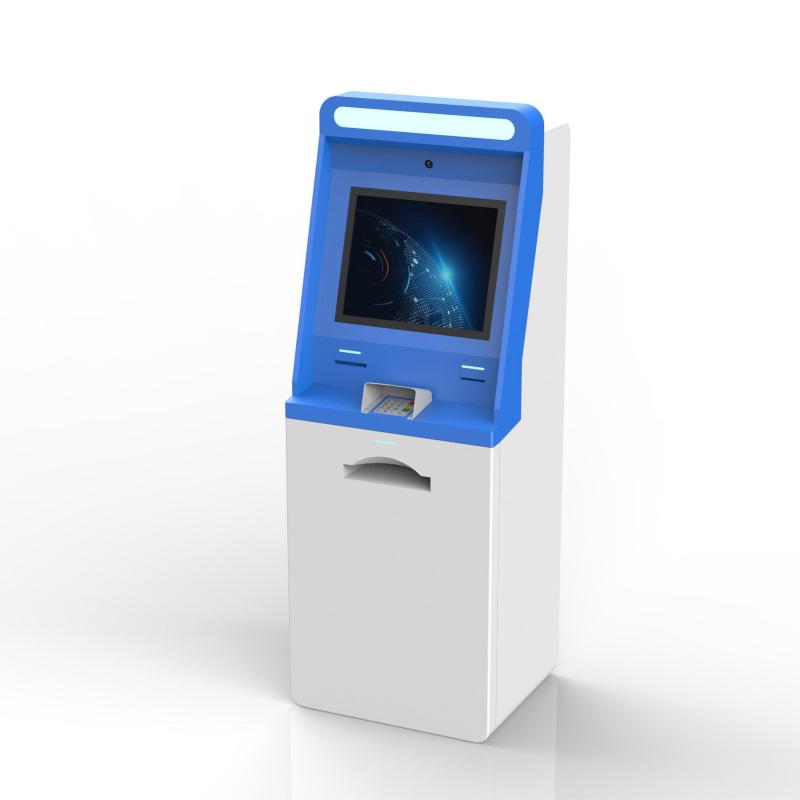
Below is a visitor kiosk video, please watch it carefully to learn more!
Watch the video above and you will find that our visitor kiosk is worth buying for its unique appearance design, stable and high-performance working performance, and fast and smooth operation experience. Contact us today to place an order and enjoy the latest price discount.
| Component | Function | Details | Example Use |
|---|---|---|---|
| Touchscreen Display | Visitor Interaction | High-resolution screen that allows users to input data, select options, and navigate. | Visitors enter their name, purpose of visit, and other details. |
| Printer | Badge Printing | Typically a thermal or inkjet printer that produces visitor badges or receipts on-site. | Printing visitor badges with name, photo, and visit details. |
| ID/Passport Scanner | Identity Verification | Optical or RFID-based scanner for reading IDs, passports, or other official documents. | Scanning a visitor's passport for identification verification. |
| Camera | Image Capture | High-definition camera that takes photos for records or security purposes. | Capturing a photo of the visitor for badge printing. |
| RFID Reader | Access Control | Reads RFID tags or cards used for access to restricted areas. | Reading an employee's access card to grant or restrict entry. |
| Barcode Scanner | Quick Identification | Scans barcodes on visitor badges, IDs, or documents for fast processing and tracking. | Scanning a barcode on a visitor's pre-issued pass. |
| Microphone & Speaker | Communication | Integrated audio system for voice communication with staff or providing voice instructions. | Staff communicates with a visitor who needs assistance. |
| Software Interface | User Guidance | Customizable interface guiding visitors through the check-in process, often touch-operated. | Visitors follow on-screen prompts to complete their check-in. |
| Network Connectivity | Data Synchronization | Wi-Fi, Ethernet, or cellular connectivity to link the kiosk with central databases and systems. | Updating visitor logs in real-time across the network. |
| Security Enclosures | Component Protection | Robust, tamper-resistant housing that protects internal hardware from damage or vandalism. | Ensures the kiosk operates safely in public spaces. |
| Thermal Printer | Durable Badge Printing | Special printer that uses heat to produce long-lasting, smudge-proof badges. | Printing high-quality, durable visitor badges. |
| Data Storage | Information Retention | Secure storage solutions, either local or cloud-based, for saving visitor data and logs. | Storing visitor records for compliance and reporting purposes. |
| Power Supply | Electrical Power | Power components providing consistent electrical current to all kiosk parts. | Ensuring the kiosk remains operational throughout the day. |
A visitor kiosk streamlines the check-in process, making it efficient and secure. Upon arrival, visitors interact with the kiosk, which prompts them to input their details, such as name, contact information, and the purpose of their visit. Some kiosks also allow visitors to scan their ID or a pre-issued QR code for quick identification. The kiosk may capture a photo for security and print a visitor badge with relevant information. Once the check-in is complete, the system can notify the host of the visitor’s arrival, ensuring a smooth and well-organized entry process.

Approach the Kiosk: Go to the kiosk, usually near the entrance.
Start Check-In: Tap the screen to begin.
Enter Details: Input your name and visit purpose, or scan your ID or a QR code.
Take Photo: If required, the kiosk may take your photo.
Print Badge: The kiosk will print a visitor badge with your information.
Notify Host: The system may alert the person you’re visiting.
Proceed: Wear your badge and head to your destination.
Check-Out: If needed, check out on the kiosk when leaving.

Corporate Offices: Manage guest check-ins and enhance security.
Healthcare: Streamline patient check-ins and track visitors.
Schools: Control visitor access and manage event check-ins.
Government Buildings: Monitor visitor access and maintain records.
Hotels: Speed up guest check-ins and provide event management.
Retail: Offer customer service and appointment scheduling.
Industrial Sites: Manage contractor check-ins and provide safety information.

Streamlined Check-In: Simplifies and speeds up the visitor registration process, reducing wait times and improving efficiency.
Enhanced Security: Captures and records visitor information, issues badges, and can integrate with access control systems for better security.
Improved Accuracy: Reduces manual entry errors by automating data capture and processing.
Increased Efficiency: Frees up staff time by handling routine check-in tasks, allowing employees to focus on other responsibilities.
Customizable Experience: Allows for tailored visitor experiences, including personalized greetings, instructions, and access to relevant information.
Real-Time Notifications: Alerts hosts when their visitors arrive, ensuring timely communication and better management of guest interactions.
Data Collection and Reporting: Provides valuable insights and reports on visitor traffic, patterns, and behavior for improved decision-making and planning.

| Type | Description | Common Sizes | Price Range |
|---|---|---|---|
| Desktop Kiosk | Compact unit for desktops or counters, ideal for small spaces and low-traffic areas. | 15-24 inches (width) x 10-20 inches (depth) | $1,000 - $3,000 |
| Floor Standing Kiosk | Tall unit designed to stand on the floor, suitable for high-traffic areas like lobbies. | 40-60 inches (height) x 20-30 inches (width) | $3,000 - $7,000 |
| Wall-Mounted Kiosk | Attached to walls, saving floor space and ideal for areas with limited room. | 20-30 inches (width) x 10-20 inches (depth) | $1,500 - $4,000 |
| Outdoor Kiosk | Weather-resistant kiosk designed for outdoor use, often used in public areas and transit stations. | 50-70 inches (height) x 30-40 inches (width) | $5,000 - $10,000 |
| Tablet Kiosk | Uses tablets mounted in enclosures, flexible and easy to relocate. | 10-15 inches (tablet size) | $500 - $2,000 |
| Interactive Kiosk | Features touchscreen interfaces with multimedia capabilities for engaging visitor interactions. | 40-60 inches (height) x 20-30 inches (width) | $4,000 - $8,000 |
| Custom Kiosk | Tailored to specific needs with bespoke designs and functionalities. | Varies based on customization | $7,000 - $20,000+ |
1. Design and AestheticsExterior Finish: Choose from various materials like metal, acrylic, or wood, and finishes including colors, textures, and branding. Form Factor: Select between desktop, floor-standing, wall-mounted, or outdoor models to fit your space and usage needs. | 2. Display and InteractionScreen Size and Type: Options range from small tablets to large touchscreens. Consider whether you need high-definition displays or multi-touch capabilities. Interactive Features: Custom interfaces, multimedia capabilities (videos, animations), and touch-free interaction options (proximity sensors). |
3. Hardware IntegrationID Scanners and Cameras: Integrate with barcode readers, RFID scanners, or passport readers for various identification methods. Printers: Options include thermal printers for badges or receipt printers for transaction records. | 4. Software CustomizationUser Interface: Tailor the on-screen interface to match your branding and operational requirements. Include custom forms, greetings, and instructions. Functionality: Integrate with existing systems for data synchronization, visitor notifications, and security features. |
5. ConnectivityNetwork Options: Choose from wired (Ethernet) or wireless (Wi-Fi, cellular) connectivity based on your network infrastructure. Integration: Ensure compatibility with your current systems, including CRM, access control, and data management software. | 6. Accessibility FeaturesADA Compliance: Include features for accessibility, such as adjustable heights, audio instructions, and visual aids for users with disabilities. |
Material Choices: For outdoor kiosks, select weather-resistant materials and ensure protection against environmental factors like rain, sun, and dust.
1. Purpose and LocationUsage: Define the primary function (e.g., check-in, information display) and where the kiosk will be located (indoor, outdoor, high-traffic areas). Traffic Volume: Choose a kiosk that can handle the expected volume of visitors and ensure it has the appropriate durability and features. 2. BudgetInitial Cost: Consider the price of the kiosk itself and any additional costs for customization and installation. Ongoing Costs: Account for maintenance, software updates, and any subscription fees for additional features. | 3. Technical Support and WarrantySupport Services: Verify the availability of technical support for troubleshooting and repairs. Warranty: Check the warranty period and coverage details to protect your investment. 4. Scalability and FlexibilityFuture Needs: Choose a kiosk that can be upgraded or modified to accommodate future changes or additional functionalities. Modular Design: Consider modular kiosks that allow for easy updates or expansions. |
Regulations: Ensure the kiosk complies with relevant regulations and standards, such as ADA requirements.
Data Security: Implement features that protect visitor data and ensure secure processing and storage.
What did our happy clients say?
The visitor kiosk we purchased has greatly streamlined our check-in process. The setup was easy, and the interface is user-friendly. It has significantly improved our visitor management and security.
We love the sleek design of our new visitor kiosk. It fits perfectly in our lobby and enhances our company’s professional image. The real-time notifications are a game changer for our reception team.
The customization options were fantastic. We tailored the kiosk to match our brand, and it integrates seamlessly with our existing systems. Visitors appreciate the quick and efficient check-in.
Our visitor kiosk has been a valuable addition to our office. The automated badge printing and photo capture features have made our check-in process faster and more secure. Highly recommend!